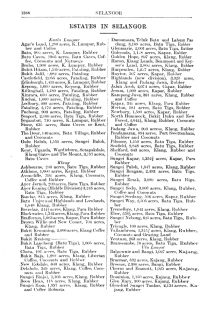This is an old revision of the document!
Jadual Kandungan
Cebisan Sejarah Kajang
Koleksi beberapa peristiwa di sekitar Kajang, yang ada direkodkan dalam sumber-sumber setakat yang dapat diperolehi di Internet, dan disusun menurut kronologi peristiwa. Antara sumber utama ialah Arkib Negara Malaysia, keratan-keratan akhbar di NewspaperSG (arkib digital akhbar tempatan yang beribu pejabat di Singapura sejak tahun 1827, kelolaan National Library Board (NLB) of Singapore), serta MyRepositori (arkib digital akhbar tempatan, kelolaan Perpustakaan Negara Malaysia). Pada setiap peristiwa, selain ringkasan liputannya, ditambahkan juga beberapa catatan ringkas atau capaian mengenai perkara atau tempat yang berkaitan, berdasarkan makalah-makalah dan kertas kerja para ilmuwan dan pengkaji sejarah, setakat yang ada di Internet sahaja.
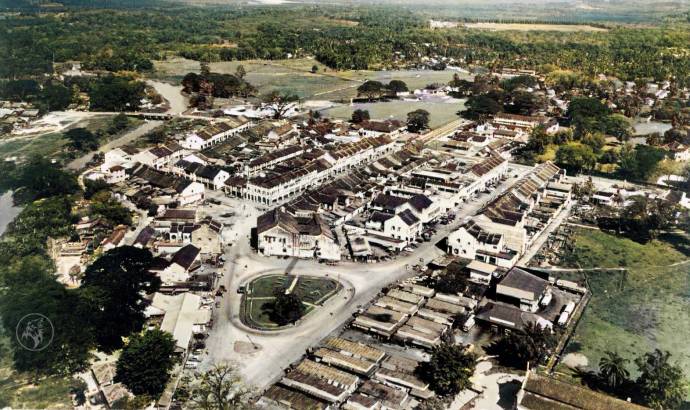
Gambar hiasan: Bandar Kajang sekitar tahun 1960-an (diwarnakan): Vijaya Kumar Ganapathy @ Facebook, 12 Julai 2021: |"An Air View' of a part of Kajang Town in the 1960's").
Alam Sekitar
Kronologi
1830-an: Pembukaan Kajang
Sementara itu, sekitar tahun 1830-an, terdapat beberapa riwayat pembukaan Kajang (di sebelah utara Rekoh), melibatkan To' Lili (Bugis dari Riau), dan Raja Berayun (dari Mandailing):-
Sumber 1: Selangor Journal (1897)
“Mengikut Selangor Journal (1897), Kajang didirikan oleh Inche Lili dari Riau 120 tahun sebelum itu, iaitu pada tahun-tahun 1770-an, di bawah naungan Sultan Muhammad. … Oleh kerana air bah, Inche Lili mendapat restu daripada Sultan Muhammad untuk berpindah meninggalkan Kajang ke kaki bukit di dekat muara Sungai Merbau. Inche Lili memberi nama pemukiman barunya itu 'Bandar Kajang', sama seperti nama tempat pemukimannya sebelum itu. (J.M. Gullick, ed., Selections from Selangor Journal, Kuala Lumpur: MBRAS, 2007, 80, memetik keterangan seorang penghulu Kajang pada 1890-an). Sultan Mohamed mengangkat Inche Lili menjadi Dato' Bandar Kajang dan mengaungerahkannya 'cap kuasa' (ertinya wewenang) untuk memerintah kawasan itu, mulai dari Sabak Dua hingga ke hilir Sungai Subang Hilang. Setelah Tok Lili meninggal dunia, Sultan Abdul Samad memindahkan kuasa kepada Toh Bandar Patok dan Nakhoda Umar, kedua-duanya kaum kerabat Tok Lili, untuk menggantikannya.” (Abdur-Razzaq Lubis, 2021: "Tarikh Raja Asal: Derap Perantauan Kaum Mandailing dari Sumatra ke Tanah Semenanjung", m.s.225).
Versi penuh dari sumber asal:-
“TRADITIONS OF ULU LANGAT
The following incidents are taken from statements made by Penghulus Raja Mahmud, of Semenyih, Said Yahya, of Cheras, and Jahya of Kajang, respectively, concerning the origin of the various settlements under their charge, and may be of interest to your readers. Of course I cannot be responsible for the statements made but have collected the information as it was otherwise likely to be lost, and as it may prove of some slight assistance to some future compiler of a history of the State. The only important omission is the early history of the settlement at Ulu Langat, which has not yet been written. It was formerly under the rule of the Toh Langat, who was, however, a personage of less importance than the Toh Unku Klang. The Dusun Tua (or “Old Orchard”) at the Hot Springs was, it need hardly be said, originally planted by Sakais, but was appropriated by one Si Timah, a daughter of Toh Langat, who sold it to the “Towkay Bahru” of Ulu Langat. Toh Langat's boundaries are said to have been Sungei Sabak Dua, Bukit Blachan, Bukit Rang and Ginting Peras.” (1897: The Selangor Journal: Jottings Past and Present, Volume 5, hlm.305-306).
“The Penghulu of Kajang states that Kajang is about 120 years old, and that it was founded by Toh (then Inche Lili, of Rio, under authority from Sultan Mohamad ibni-el Marhum Sultan Ibrahim, who had brought him as one of his following from Rio to Selangor.
The boundaries of Inche Lili's domain were the district of Ulu Langat from Sungei Sabak Dua upstream following the Dato' Langat's boundary and downstream following the boundary of Dato' Ali as far as Subang Hilang. Inche Lili's first arrival was not very auspicious; the new settlers on their first voyage up the Langat River had to force their way through the dense and thorny growth of rattans and screw-palms which then all but met across the stream. They presevered, however, and build themselves houses near the head waters of the Sungei Kajang where Haji Mat Nor now resides.
Their new houses were roofed with hastily improvised awnings (or “kajangs”) of pandanus leaves, there being no bertam leaves obtainable on the spot (which was then a mere swamp), and hence Kajang town and river got their names. Owing to the excessive dampness of the locality, however (it is said that a flood “lifted” off the roofs of their houses, after which the name of the stream was lengthened to Sungei Kajang Ber-angkat). Inche Lili and his following (six in number) found themselves compelled to move to a drier situation, though not before they had reaped their first padi-crop, which brough them in 4,000 gantangs of padi. On determining to move Inche Lili's first step was to pay a visit to Kuala Langat in order to obtain an audience from Sultan Mahomad at Telok Pulai. He had no difficulty in effecting this, and obtained permission from H.H. the Sultan to move to any place he liked. Inche Lili and his following accordingly removed and established themselves at the foot of the hill near the mouth of Sungei Merbu, and gave to the new settlement the name of Bandar Kajang, after the place they had abandoned. At Kuala Merbu he afterwards received a visit from H.H. Sultan Mahomad, who proclaimed him Dato' Bandar of the “district” of Kajang, and gave him a seal with authority to rule the country from Sabak Dua downstream as far as Subang Hilang. After staying about 15 days, the Sultan returned to Kuala Langat, leaving instructions for the new Dato' Bandar to try and start mining operations at Sungei Merbu. Toh Lili, as he must now be called, set to work by introducing three Chinese Towkays from Klang (? Kuala Lumpur) - viz. Ah Nyu, Ah Pow and Kah Sut - who commenced work at first with only ten coolies. The mining was successful and the three Towkays made enough to retire on, in spite of the low price of tin. Eventually the first-named Towkay died at Kajang, the second returned to Klang, and the third to China. Later, one Ah Keh (a Hokien Chinese from Kanchong) started to mine Sungei Kladi in company with Chay Toon, and the “Towkay Bahru” got authority from Raja Abdul Samad to open the local “Farms”.” (1897: The Selangor Journal: Jottings Past and Present, Volume 5, hlm.306-307).
Ulasan Sumber
Tarikh tahun 1770-an ini dianggap tidak tepat kerana tempoh pemerintahan Sultan Muhammad ialah tahun 1826-1857: “Riwayat dan pentarikhan ini jadi masalah (Mengikut versi ini, Kajang dibukan sekitar 1777; pada waktu itu, yang memerintah adalah Raja Lumu gelar Sultan Salehuddin (1766-1782), iaitu Sultan Selangor yang pertama. Sultan Muhammad hanya naik takhta pada 1826 dan memerintah sampai 1857, dan sebelum itu sebagai Raja Muda (1801-1826)).” (Abdur-Razzaq Lubis, 2021: "Tarikh Raja Asal: Derap Perantauan Kaum Mandailing dari Sumatra ke Tanah Semenanjung", m.s.225). Dari sumber asal: “The traditions of Kajang date its foundation to the 1770s, but there are difficulties of chronology that suggest that, if it was founded so early, it was small and of little importance until the reign (1826-57) of Sultan Mohamed, who granted to a Rhio Bugis, To' Lili, the title of Dato' Shahbandar with authority over Kajang and its environs. The story is that To' Lili applied to the Sultan at Telok Piei (Kuala Selangor) with the credentials of having led a party up the Langat River 'through dense and thorny growth of rattans and screw pines which then all but met across the stream'. They 'built themselves houses near the head waters of the Sungei Kajang', so named because the houses were roofed with 'hastily improvised awnings (or “kajangs”) of pandanus leaves, there being no bertam leaves obtainable on the spot'. Sultan Mohamed is reported to have visited Kajang later on, where To' Lili had begun to mine for tin. The story, as told in 1895, asserted that To' Lili founded Kajang 120 years before, i.e. in 1775, but that is irreconcilable with the involvement of Sultan Mohamed, whose reign began in 1826. The foundation of Cheras and Semenyih also is dated by legend as c. 1855.” (J. M. Gullick @ Journal of the Malaysian Branch of the Royal Asiatic Society Vol. 80, No. 2 (293) (December 2007): |"A Short History of Ulu Langat to 1900", m.s.4-5).
Sumber 2: Shahabuddin Ahmad (1975)
“Terdapat fakta yang menyebut bahawa Kajang telah dibuka oleh ayah kepada Raja Alang iaitu Raja Berayun. Raja Berayun ialah seorang anak raja yang melarikan diri ke Selangor dari peperangan saudara di Sumatera. Di negeri Selangor beliau telah bersahabat baik dengan Sultan Abdul Samad. Raja Berayun kemudiannya telah membuka Kajang dan memerintah daerah Kajang dengan gelaran Tengku Panglima Besar.” (MAJLIS PERBANDARAN KAJANG (MPKj), 2006: |"SEJARAH KAJANG").
“Menurut Shahabuddin Ahmad, pengkaji sejarah tempatan Kajang, Raja Barayun yang 'telah membuka Kajang dan memerintah daerah Kajang dengan gelaran Tengku Panglima Besar', setepatnya, Tunku Panglima Raja. (Pemukiman di Kajang yang dibuka oleh Raja Barayun itu dekat dengan 'Jalan Mendaling' sekarang. http://www.mpkj.gov.my/main.asp?MPKj=wan&profil=2&S=2&tajuk=Sejarah%20Kajang#2 ….. Catatan pada laman web tersebut (Majlis Perbandaran Kajang) diambil daripada pengkaji sejarah tempatan Shahabudin Ahmad, 'Asal Nama Kajang Dan Sekitarnya', Minggu Sejarah Negeri Selangor 16-18 Julai, 1975, Persatuan Sejarah Malaysia Cawangan Selangor (Buku Cenderamata).” (Abdur-Razzaq Lubis, 2021: "Tarikh Raja Asal: Derap Perantauan Kaum Mandailing dari Sumatra ke Tanah Semenanjung", m.s.19, 225).
1850-an: Perkembangan Rekoh
- Rujuk: Rekoh
1896: Peta
Kiri: Peta pekan Kajang tahun 1896: “A closeup of 1896 map of Kajang Town. British Colonial Government then did some segmentation of the town from section 1- section 9. Early development concentrated in Section 1-4 along Jalan Mendeling, Jalan Tukang, and later extended to Jalan Besar(Main Street) and Jalan Tengah(Middle Street). The present Metro Plaza site was a tin mine by Towkay Chow Yoke who owned the row of shop houses along Main Street. If you notice a bridge over Langat River, it was not at present site. The wooden bridge link from Lorong Mendeling to the opposite bank at about 50m down the river from the present location. This is something interesting we found from National Archive. Credit to our research assistant Kah Hoe Lee who had been flipping through files and documents for months. 乌鲁冷岳社区文物馆增添了不少的新资料,都是我们的研究助理李家和全心投入,翻查国家档案馆资料,找出加影开埠历史记录。这1896年地图标出当年城市规划,最早的建筑集中在后街,杜更街;大街一排店屋,较后由赵煜(荣)兴建。地图上的矿湖,位于现今美景广场地段,属赵煜所有。至于横跨冷岳河的木桥,当时是建在后街巷口处,离目前的桥梁,大约50公尺。” (Kajang Heritage Centre, 16 November 2019: "A closeup of 1896 map of Kajang Town").
Tengah: Peta pekan Kajang, sebahagian daripada peta tahun 1945: “Scale: Scale 1:7 500 (E 101°47'/N 2°59'); Description: [London] : published by War Office, 1945; 1 map : col. ; 49 x 42 cm.; Notes: Town plan of Kajang showing transportation, water features, vegetation, cultivation, built-up areas and buildings. Relief shown of hachures. At top of map: Malaya. Prime meridian: Greenwich. “2,500/9/45 S.P.C.”.” (Great Britain. Royal Air Force. Central Interpretation Unit, 1945 @ National Library of Australia digitised item: |"Town plan of Kajang [cartographic material]/ compiled and drawn by A.C.I.U. and War Office").
Kanan: Peta pekan Kajang, 2025 (Google Maps, 2025).
1904
Di dalam surat bertarikh 22 Jun 1904, Residen Selangor, Henry Conway Belfield telah mengarahkan seluruh pegawai-pegawai daerah di negeri itu menyediakan senarai semua lokasi-lokasi utama di dalam daerah mereka, serta jarak setiap lokasi tersebut dari stesen atau pelabuhan terdekat:-
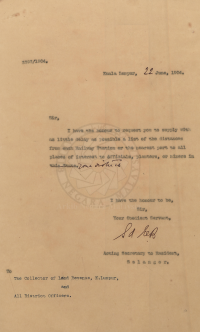
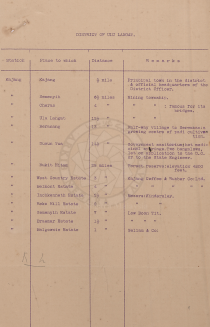
“Kuala Lumpur, 22 June, 1904. Sir, I have the honour to request you to supply with as little delay as possible a list of the distances from each Railway Station or the nearest port to all places of interest to officials, planters, or miners in your district. … Sd HcB (Henry Conway Belfield): Acting Secretary to Resident, Selangor. To The Collector of Land Revenue, K. Lumpur, and All District Officers.”
Senarai lokasi bagi daerah Ulu Langat:-
| Station | Place to which | Distance | Remarks |
|---|---|---|---|
| Kajang | Kajang | 1/2 mile | Principal town in the district & official headquarters of the District Officer. |
| “ | Semenyih | 6 1/2 miles | Mining township. |
| ” | Cheras | 4 “ | ” “ : famous for its bridges. |
| ” | Ulu Langat | 12 1/2 “ | ” “ |
| ” | Beranang | 13 “ | Half-way village to Seremban: a growing centre of padi cultivation. |
| ” | Dusun Tua | 14 1/2 “ | Government sanitorium: hot medicinal springs. Two bungalows, let on application to the D.O. or the State Engineer. |
| ” | Bukit Hitam | 25 miles | Forest reserve: elevation 4800 feet. |
| “ | West Country Estate | 3 ” | Kajang Coffee & Rubber Co:Ltd. |
| “ | Belmont Estate | 4 ” | “ ” “ ” “ |
| ” | 2 1/2 “ | Messrs:Kindersley. | |
| ” | Reko Hill Estate | 2 “ | ” “ |
| ” | Semenyih Estate | 7 “ | Low Boon Tit. |
| ” | Braemar Estate | 1 1/2 “ | ” “ ” |
| “ | Balgownie Estate | 1 ” | Sellam & Co: |
(Sumber: Arkib Negara 1957/0116784W, 17/06/1904: |"LIST OF DISTANCES FROM EACH RAILWAY STATION OR THE NEAREST PORT TO ALL PLACES OF INTEREST TO OFFCIALS ETC").

Peta sekitar Kajang, 1904 (Edinburgh Geographical Institute, 1904 @ Yale University Library - Digital Collections: |"Selangor, Federated Malay States, 1904 / John Bartholomew & Co ; W.T. Wood, chief draftman").
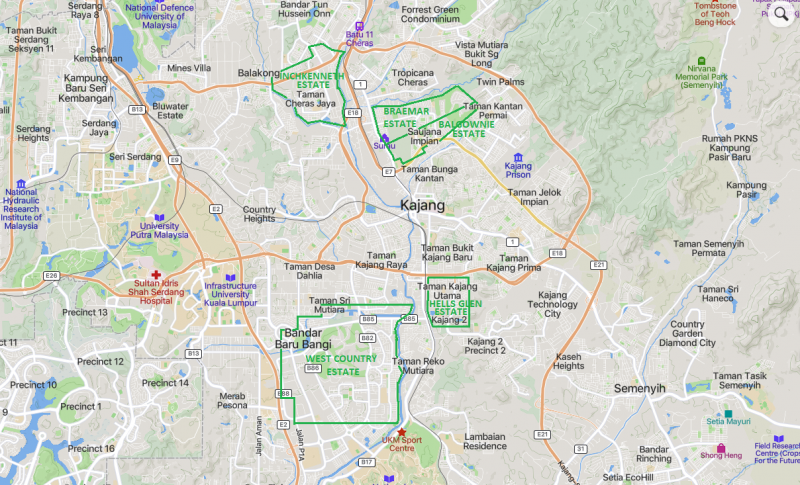
Peta sekitar Kajang, kini (Mapcarta).
Antara ladang-ladang terawal di sekitar Kajang (1904), dan lokasinya kini:-
| Ladang | Lokasi Kini |
|---|---|
| West Country Estate | Bandar Baru Bangi Seksyen 1,2,3,4,6,7,8, Padang Golf |
| Inch Kenneth Estate | Taman Cheras Jaya, Taman Taming Maju |
| Braemar Estate | Saujana Impian, Impian Golf & Country Club, SMA Persekutuan Kajang, Taman Delima, Taman Mesra |
| Balgownie Estate | Saujana Impian, Impian Golf & Country Club, SMK Sultan Abdul Aziz Shah |
1912
Ladang-ladang yang tersenarai di daerah Ulu Langat pada tahun 1912:-
| Estates | Acreage | Location | Plantation |
|---|---|---|---|
| Balgownie and Bangi | 1,027 acres | Kajang | Rubber |
| Braemar | 532 acres | Kajang | Rubber |
| Broome | 2,300 acres | Bangi | Rubber |
| Cherns and Emmott | 1,025 acres | Kajang | Rubber |
| Dominion | 1,150 acres | Kajang | Rubber |
| Glen Mary | 300 acres | Kajang | Rubber |
| Glenshiel Sungei Tankas | 2,134 acres | Kajang | Rubber |
| Inch Kenneth, Reko Hill and Dunedin | 1,673 acres | Kajang | Rubber |
| Jendram | 1,000 acres | Bangi | Rubber |
| Madingly | 1,000 acres | Kajang | Rubber |
| Paradise | 590 acres | Kajang | Rubber |
| Semenyih | 710 acres | Kajang (7th mile) | Rubber |
| Sungei Rinching | 1,125 acres | Kajang | Rubber |
| The West Country, Belmont, Aier Hitam, Colwall and Eastnor | 7,210 acres | Kajang | Rubber |
(Hongkong Daily Press Office, 1912: "The Directory & Chronicle for China, Japan, Corea, Indo-China, Straits Settlements, Malay States, Siam, Netherlands India, Borneo, the Philippines, & c": “ESTATES IN SELANGOR”, m.s.1386-1387).
1945

Peta lama Kajang (1945): “Scale: Scale 1:7 500 (E 101°47'/N 2°59'); Description: [London] : published by War Office, 1945; 1 map : col. ; 49 x 42 cm.; Notes: Town plan of Kajang showing transportation, water features, vegetation, cultivation, built-up areas and buildings. Relief shown of hachures. At top of map: Malaya. Prime meridian: Greenwich. “2,500/9/45 S.P.C.”.” (Great Britain. Royal Air Force. Central Interpretation Unit, 1945 @ National Library of Australia digitised item: |"Town plan of Kajang [cartographic material]/ compiled and drawn by A.C.I.U. and War Office").
1980-an

Peta lama Kajang (akhir 1980-an): “This is an old map of Kajang. Development in Kajang town and its suburds is moving at a pace too fast. Its urban landscape is changing and the natural surrounding transforms. Township modernization starting from late 80s has disturbed the easy-going lifestyle of this southern town of Selangor.” (Kajang Heritage Centre乌鲁冷岳社区文物馆, 2 Ogos 2015: "This is an old map of Kajang").
Pengakuan Penting: Kami Bukan Ahli Sejarah!
Perlu ditekankan, kami bukan ahli sejarah! Laman ini sekadar mengumpulkan cebisan maklumat berkaitan sejarah Kajang dan kawasan sekitarnya, setakat yang dapat ditemui di ruang Internet sahaja. Maka pastinya ia amat tidak lengkap, tidak menyeluruh, dan kurang wibawa berbanding karya ilmiah hasil kajian para sejarawan. Perlu diingatkan juga, sumber-sumber yang dinyatakan di sini adalah dari pelbagai sudut pandang dan latar para ilmuwan, pengkaji, wartawan dan editor akhbar, bermula dari awal kurun ke-20 (zaman kolonial British), sehingga kini. Kami cuba menyampaikan kesemuanya secara objektif, namun perlulah juga diakui, terdapat juga kecenderungan kami sendiri, yang terserlah di dalam ulasan dan catatan kami. 
Apa pun, anggaplah ini sebagai usaha pemula sahaja. Selebihnya perlu digali dari sumber-sumber berwibawa yang lain, seperti karya-karya sejarawan, arkib-arkib perpustakaan, muzium, atau premis dan petempatan bersejarah (awam atau persendirian), termasuk juga sejarah lisan warga asalnya. Sebaiknya, semua usaha ini harus dirujuk atau diusahakan bersama para ahli/pakar bidang sejarah. Aktiviti sebegini seharusnya terus giat dijalankan dan disebarluaskan oleh sekolah-sekolah dan institusi-institusi pendidikan di sekitar Kajang.
Contoh Usaha Pensejarahan
Berikut adalah contoh hasil usaha pensejarahan tempatan yang telah dijalankan untuk bandar Kajang, yang perlu dicontohi oleh institusi-institusi di Bangi:-
- Kajang Heritage Centre oleh |Lee Kim Sin (1955-2020) (Kurniawati Kamarudin / Bernama @ Media Permata, 26 Disember 2019: |"Tarikan sejarah bandar Kajang").
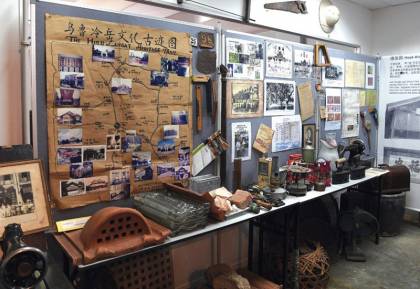
“Occupying the second floor of a 4-storey shoplot in Jalan Mendaling, the Kajang Heritage Centre honours this forgotten history with over 300 artefacts such as typewriters, clothing, furniture, photos and documents rescued from old businesses. Aside from the museum, you can also experience the Kajang Heritage Walk for a guided tour of the heritage sites around the district, including the Century Old Shen Sze She Tar Temple, Masjid Jamek Kajang, Century Old Tin Mine at Bukit Arang and more.” (Natalie Khoo, 28 September 2020: |"6 historical museums in Selangor for an insightful blast from the past").
Rencana Pusat Warisan Kajang (RTM) (TV2, 5 Mei 2016: "《老加影之乌鲁冷岳社区文物馆》").
Rencana Pusat Warisan Kajang (KPKT) (Kementerian Perumahan Dan Kerajaan Tempatan, 2019: "Siri Muzium dan Perpustakaan Komuniti Kampung Baru 2").
Rencana Pusat Warisan Kajang (sumbertv, 2023: "Kajang 2: Peranan Kajang Heritage Centre").
- Buku berjudul “Kajang And Its Surrounds: Glimpses from the past…”, oleh Tanarata International Schools (Choo Woon Lim @ The Star, 02 Dec 2014: |"Penning down the past").

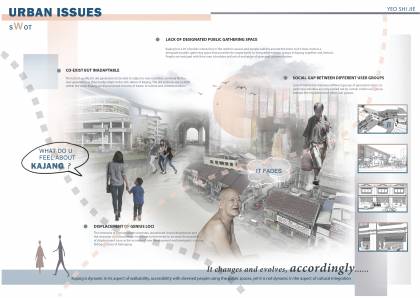
Antara kesan penting kegiatan pensejarahan tempatan yang aktif ialah budaya perancangan bandar yang peka terhadap warisan sejarah dan budaya semasa yang perlu dipelihara dan diraikan seadanya, selain memajukan persekitarannya. Sebagai contoh: latihan kajian pra perancangan Kajang ini tampaknya sensitif terhadap budaya dan sejarah setempat, kemungkinan kesan usaha pensejarahannya sejak beberapa dasawarsa: “The various culture of Kajang & people unfolding through layers of diversity … Sense of belongings with enrichment of old culture, the business that runs on the day & everyday, to make sure the life is on-going … The lack of quality for old generation to be able to adjust to new condition, similarly for the new generation as they hardly adapt to the old culture of Kajang. The old and new are co-exist within the same Kajang yet disconnected in terms of fusion of culture and communication. … The remnants of unmaintained structures, abandoned closed shophouses and the recession of old businesses from time to time tends to increase the possibility of displacement issue as the increase of new development and immigrants causing fading of sense of belonging. … Kajang is dynamic in its aspect of walkability, accessibility with diversed people using the public spaces, yet it is not dynamic in the aspect of cultural integration.” (Yeo Shi Jie, Jul 30, 2020: |"[ A DYNAMIC KAJANG: SITE B ] - Project 1 - 'Preliminary Study’ - Urban Analysis & Precedent Studies").
Perihal Pensejarahan Tempatan
Beberapa penulisan, serta hasil kajian kritis berkaitan pensejarahan tempatan secara umum, sebagai panduan:-
- Masalah-masalah pendidikan sejarah tempatan secara umum, serta beberapa cadangan bagi pembaikpulihan: Profesor Emeritus Ahmat Adam @ SUSURGALUR: Jurnal Kajian Sejarah & Pendidikan Sejarah, 2(1) Maret 2014: |"Pendidikan Sejarah di Malaysia Dewasa ini: Sejauh Manakah ia Relevan kepada Pembinaan Nasion?".
- Perlunya persejarahan mikro (daerah, kampung, kawasan setempat): |"Sejarah Selangor terbengkalai" (latifah@bh.com.my @ Berita Harian, Mei 6, 2015).
- Peri pentingnya arkib akhbar dalam proses pensejarahan tempatan: Prof Dato’ Dr Ahmad Murad Mohd Noor Merican @ New Straits Times, May 29, 2019:|"A window to Malaysian society".
- Nota ringkas mengenai kajian kerencaman perspektif sejarah tempatan: Prof Dato’ Dr Ahmad Murad Mohd Noor Merican, 2014: |"The New Media and the Consciousness of History in Malaysia: Ideas on National History and Other Histories". Contoh hasil kajian berkaitan: Muhaimin Sulam, Norena Abd Karim Zamri and Ahmad Murad Merican, 2018: |"The Consciousness of History in Malaysia: The Ideas on Merdeka Day in Sarawak".
- Beberapa penulisan dan suntingan Dr Azmi Arifin bertemakan penilaian dan penafsiran semula sejarah tempatan secara kritis, dalam acuan sendiri:-
Akhir kata, silakan membaca beberapa peringatan untuk kita bersama:-
Jika ada sebarang pembetulan, cadangan, maklumbalas, dsbgnya, silalah hubungi kami di sini. Semoga bermanfaat!





